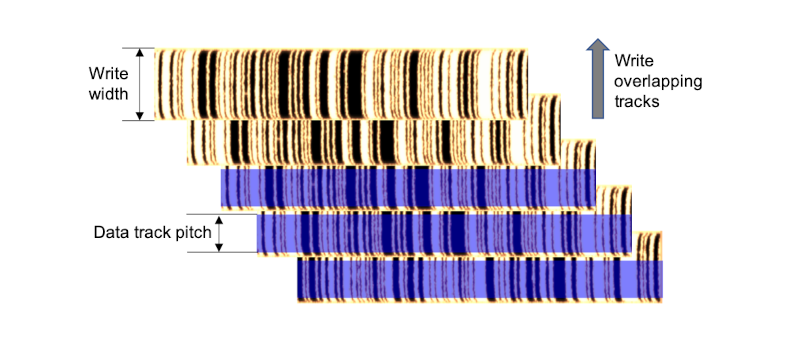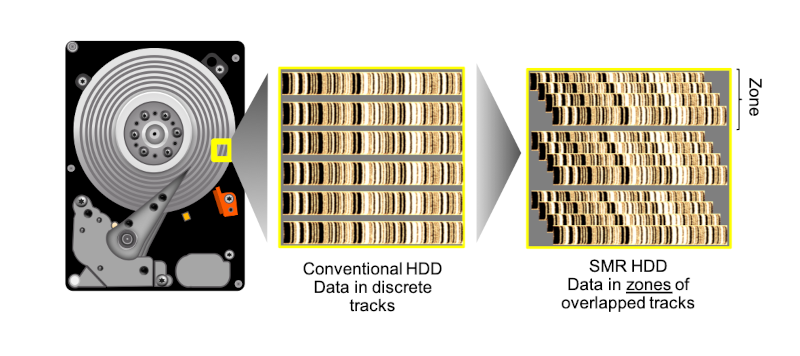Shingled Magnetic Recording Hard Disks
Shingled Magnetic Recording (SMR) is a magnetic storage data recording technology that is used in hard disk drives (HDDs). Compared to drives of the same generation that use conventional magnetic recording (CMR) technology, Shingled Magnetic Recording provides increased areal density. This increased areal density results in a higher overall per-drive storage capacity when compared to CMR drives.
SMR Overview
Conventional magnetic recording places gaps between recording tracks on hard disk platters to account for Track mis-registration (TMR) budget. These separators impact areal density, because portions of the platter surface are not fully utilized to store user data. Shingled magnetic recording removes the gaps between tracks by writing the tracks in an overlapping manner, forming a pattern similar to the shingles on a roof. Physically, this is done by writing the data sequentially and then overlapping (or “shingling”) it with another track of data. By repeating this process, more data tracks can be placed on each magnetic surface than can be placed on an equal amount of magnetic surface in a drive that uses conventional magnetic recording technology. The figure below illustrates this principle.

The write head that is designed for SMR drives is wider than is necessary for it to write a single track of data. This greater width produces a stronger magnetic field that is suitable for magnetizing films of high coercivity. After one track has been written, the recording head is advanced by only part of its width. This means that the next track partially overwrites the previous one, leaving only a narrow band of the previous track readable.
Overlapping tracks are grouped into bands called "zones". These zones are of fixed capacity, which promotes effective data organization and partial update capability. Recording gaps are placed between zones to prevent data from being overwritten by the wide write head. These gaps ensure that the wide write head does not overwrite the first track of a zone when it is writing the last track of the preceding zone on the same platter surface.

Fundamental Implications of SMR
The shingled format of SMR dictates that all data streams must be organized and written sequentially to the media. There are different methods of implementing SMR (see the SMR Interface Implementations section below), but the data must be written to the media sequentially regardless of which method is used. If a particular data sector has to be modified or re-written, then the entire band of tracks (the "zone") must be re-written. Because the modified data sector could be under another “shingle” of data, direct modification is not permitted. This is never the case in traditional CMR drives.
To modify a sector in a track (when using SMR), you must rewrite the row of shingles above the track containing the target sector. SMR hard disks provide true random-read capability, allowing rapid data access in the way that you've come to expect from traditional CMR drives. This makes SMR an excellent technology candidate for both active archive and higher-performance sequential workloads.
Governing Standards
A specification for commands has been defined for SMR hard disks that implement the host-managed and host-aware models. These command interfaces are standards-based and have been developed by the INCITS T10 committee for SCSI hard disks and by the INCITS T13 committee for ATA hard disks. No industry standard exists for the drive-Managed model, because it is backwards-compatible and transparent to hosts.
SCSI Standard: ZBC
"Zoned Block Command (ZBC) revision 05" is the standard that defines zone management commands and read/write command behavior for Host-Managed and Host- Aware SCSI drives. The ZBC specification defines the model and command-set extensions for zoned block devices, and have been implemented in conjunction with the applicable clauses of the SPC-5 and SBC-4 specifications.
Acquiring the SCSI ZBC Standard
The Zoned Block Commands specifications document is published as ANSI INCITS 536-2016: Information technology – Zoned Block Commands (ZBC) and can be purchased from the ANSI webstore. This document is available at no cost to INCITS T10 member companies. Contact INCITS for further information.
ATA Standard: ZAC
The Zoned Device ATA Command Set (ZAC) is the standard that specifies the command set that host systems use to access storage devices that implement either the "Host-Aware Zones" feature set or the "Host-Managed Zones" feature set. The INCITS Technical Committee T13 is responsible for all interface standards that relate to the popular AT Attachment (ATA) storage interface, which is used with many disk drives. The Zoned Device ATA Command Set standard is an extension of the ATA implementation standards that are described in "AT Attachment - 8 ATA/ATAPI Architecture Model (ATA8-AAM)", and it provides a common command set for systems manufacturers, system integrators, software suppliers and suppliers of storage devices that provide one of the zone-feature sets.
Acquiring the ATA ZAC Standard
The Zoned Device ATA Command Set specifications document is published as INCITS 537-2016: Information technology – Zoned Device ATA Command Set (ZAC) and can be purchased from the ANSI webstore. This document is available at no cost to INCITS T13 member companies. Contact INCITS for further information.
SMR Interface Implementations
An SMR disk implementation can have three possible interfaces, and their differences impact hosts and users.
The first two interfaces are defined by the host-managed and host-aware zone models.
An SMR disk implementation may also choose to hide the SMR sequential write constraint to the host. This is the Drive Managed Model defined by the ZBC standard. This model handles the SMR sequential-write constraint internally (in the disk firmware) and provides a backwards-compatible interface to the host. Drive-managed disks accommodate both sequential and random writing, and can be used as a replacement for CMR drives without any modification to the host software.
The performance characteristics of drive-managed SMR disks depend on the internal disk firmware implementation, applications used and the workloads executed. This is similar to the performance of host-aware disks that are used by a host as regular drives.
SMR Zone Management
The ZAC and ZBC standards describe the set of commands that are necessary for a host application to manage zones of Host-Managed and Host-Aware drives. Although these two standards describe commands for two separate command protocols (SCSI and ATA), the zone types and zone management commands that they define are semantically identical, and the behavior of the read and write commands that they define are compatible. The ZBC and ZAC standards each define the same zone models, and those zone models are discussed in the SMR Interface Implementations section.
Zone Types
The ZAC and ZBC standards allow for two different zone types to be used with the host-managed and host-aware models.
-
Conventional zones are optional with the host-managed and host-aware SMR disks. If present, they typically occupy a very small percentage of the overall capacity of a drive.
-
Sequential-write-required zones are mandatory with the host-managed model and cannot be found on host-aware disk models. These zones are subject to the SMR sequential write constraint and thus can be written only sequentially.
-
Sequential-write-preferred zones are mandatory with the host-aware model and cannot be found on host-managed drives.
Zone Management Commands
Both the ZAC and the ZBC standards define five zone management commands as extensions of the drive's basic command set (which is similar to the set of commands defined for CMR drives).
Zone Resources Limits
The ZAC and ZBC standards define only one zone resources limit. A drive can have a limit on the number of zones that can be in the implicit open or explicit open state (open zones).
An active zone resource limit is not defined for SMR hard disks by the ZBC and ZAC standards. The user can assume that SMR hard disks do not have a limit on the number of zones that can be active (that is, on the number of zones on the drive that can be partially written).
Since host-aware drives are backwards compatible with regular CMR disks, the ZBC and ZAC standards do not define any limit on the number of open zones for this model. However, the standards define that a drive can advertize and optimal maximum number of open zones. This is a non-restrictive guideline for the host rather than an enforced limit. The host software can use this information to avoid performance degradation due to an excessive number of zone partially written on the device.
Zone Append
The ZAC and ZBC standards do not define a zone append command for SMR hard disks. However, this command semantic can be emulated by host software stacks.